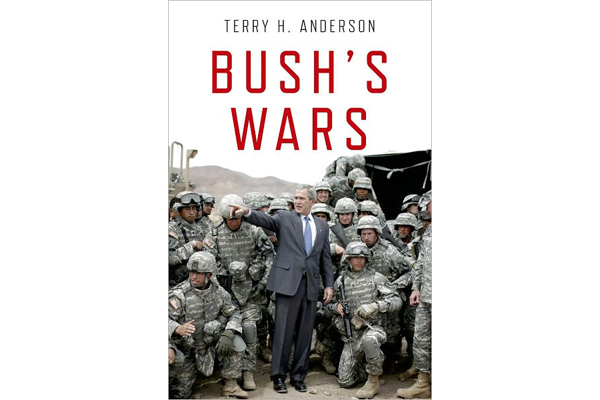Bush's Wars

George W. Bush told an interviewer last year that he would not be alive to hear history’s final verdict on his acts as president of the United States. But Terry Anderson, professor of history at Texas A&M University and a Vietnam veteran, isn’t waiting. He has written "Bush’s Wars'," a reasonably engaging account of the military actions in Afghanistan and Iraq begun by Mr. Bush in 2001 and 2003, respectively. Neither is close to being finished 2-1/2 years after he left the White House.
There have been scores of books on the two wars, of course, with various focuses and perspectives, and Anderson draws on many of them, among other sources, to create a modest, 282-page overview that begins with a short primer on the Graveyard of Empires (Afghanistan) and the Improbable Country (Iraq).
If there is much that the reader remembers – or should remember – in this work, there also are some surprising details. Among other unsettling revelations in “Bush’s Wars” is an examination of the numerous prewar misapprehensions cherished by Bush’s “neocon” advisers. What they anticipated would happen if the US invaded Iraq is, in hindsight, stunningly inaccurate:
•The administration estimated the war would cost $50 billion to $60 billion to wage; Anderson reports the actual operational tally at $750 billion and rising, not including debt service, replacement of military hardware, and ongoing care for wounded veterans, which added together will more than double that figure. (The war in Afghanistan has cost more than $350 billion to wage so far.)
•Assistant Secretary of Defense Richard Perle proclaimed, “Iraq is a very wealthy country ... they can finance, largely finance, the reconstruction of their own country.” In fact, Iraq had been decimated by two previous wars and United Nations sanctions.
This notion of a US invasion of Iraq as a geopolitical cakewalk was all the more surprising because, to gin up support for the war, the Bush administration and its supporters transformed Saddam Hussein into the mother of all boogeymen. In September 2002, Bush launched the mushroom cloud argument by declaring that Iraq was “six months away from developing a [nuclear] weapon. I don’t know what more evidence we need.”
Anderson also ably documents the litany of mistakes that contributed to the chaos that erupted in Iraq after the successful March 2003 invasion. Bush and Mr. Rumsfeld insisted on an invasion force of only 145,000 men, enough to rout Saddam’s dispirited forces but not nearly enough to secure peace and security in a fractious country larger than California. The first sign that America couldn’t control the nation it had defeated militarily was the widespread looting that erupted soon after the fall of Baghdad. Anderson writes that American officials estimated the thievery amounted to $12 billion. Insurgency and civil war soon followed, fueled by weapons freely available at Iraqi military bases that were left unguarded for lack of American manpower.
If more successful in Afghanistan, at least initially, the Bush administration also conducted that war on the cheap and America would eventually pay the price for it. In December 2001, the month the Taliban were defeated, Osama bin Laden slipped away into Pakistan when Gen. Tommy Franks assigned Afghan militia, rather than US Marines and Special Forces, the task of surrounding him in his Tora Bora redoubt.
Remarkably, the Taliban were defeated in 78 days with only a few hundred American boots on the ground – and a lot of air support for our Afghan allies. But by the end of 2001, with the Taliban routed, there were fewer than 5,000 American troops on hand initially to secure a country the size of Texas. Meanwhile, Bush, Vice President Dick Cheney, and Rumsfeld had already turned their gaze toward Iraq. Indeed, Iraq had come up in discussions of military responses as early as the afternoon of 9/11.
Anderson also reminds the reader that throughout his two terms Bush called for no sacrifices by the American people – other than those made by the military and their families – as he waged two wars. He urged his fellow Americans to go shopping and refused to raise taxes to pay for the wars. When Bush entered office, the national debt stood at $5.5 trillion, and there was a budget surplus. When he left, the national debt had doubled to $11 trillion.
The timing of this book is perhaps fortuitous. Even as President Obama announced last month the gradual withdrawal of troops from Afghanistan, “Bush’s Wars” serves the useful purpose of reminding all of us of a difficult truth: Once engaged, there is no easy exit from warfare.